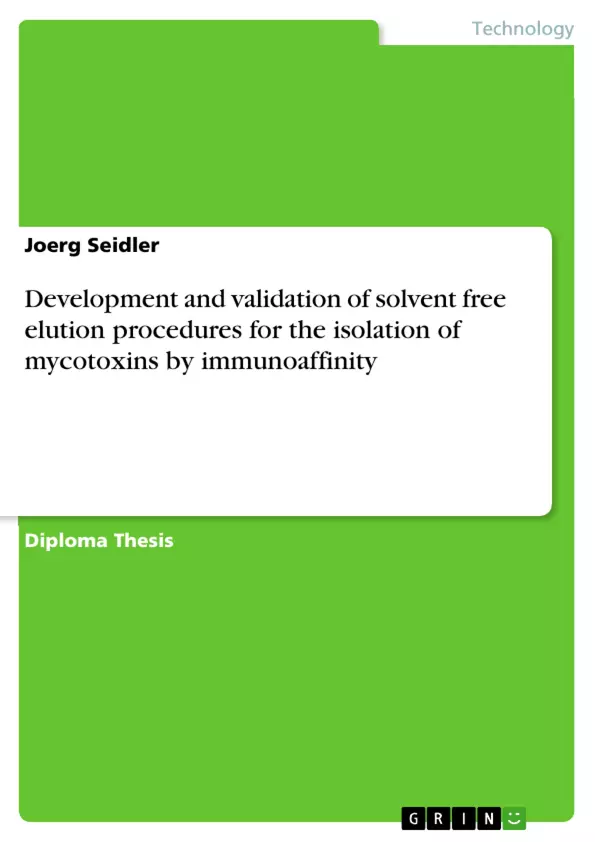To ensure the health of humans and animals, the production of safe food and feed is indispensable. All over the world, food-borne diseases are among the most widespread health problems. These health problems are either of infectious origin, e.g. Salmonella, or they are associated with the consumption of toxic products, e.g. natural toxins such as mycotoxins or industrial chemical residues as for example polychlorinated biphenols (PCBs).
Especially for natural toxins the monitoring of possible contamination in food- and feedstuffs is an important and complex issue, causing a huge investment in time and effort by many regulatory and industrial laboratories. For more than 30 years, considerable research has also been devoted to develop methods for detecting and determining mycotoxins in foods, feeds and biological fluids.
But still, demands from consumers and regulators constantly grow to improve the quality and moreover the safety of food. To supply regulators, consumers and industry with long-term solutions to the complex problems associated with chemical contaminant monitoring, the European Commission has made several calls in its 4th, 5th, 6th and the current 7th Research Framework Program to improve methodologies for mycotoxin determinations. As a result of a recent call in the 6th framework program, the so called BioCop – Project was launched. The aim of BioCop is to develop fast and cost-effective technologies for the screening of food contaminants. One approach within the project is to identify specific transcriptional "alarm" responses to phytoestrogens, organochlorine pesticides and also mycotoxins.1 The Community Reference Laboratory (CRL) for Mycotoxins as a partner in BioCop focuses on novel determination techniques for mycotoxins
Inhaltsverzeichnis (Table of Contents)
- Introduction and Scope of the work
- Theoretical Part
- Fungi, moulds and mycotoxins
- Major Groups of mycotoxins occuring in food and feed
- Food Safety Aspects and Regulations
- Mycotoxin-Analysis
- Immunoaffinity Clean-Up
- Immunosorbents and Antibodies
- Supports for Immunosorbents
- Bonding density
- Selective Extractions and Cross-Reactivity
- Capacity
- Immuno-based applications for Mycotoxins
- Determination of Mycotoxins
- Principles of reversed-phase high performance liquid chromatography (RP-HPLC)
- Individual Mycotoxins
- Liquid chromatography / mass spectrometry (LC-MS) as universal detector for multi-toxin extracts
- Results and Discussion
- Exploratory Experiments with Deoxynivalenol
- Background
- The Surveillance procedure
- pH solutions
- Heated elution procedures
- Statistical analysis
- Zearalenone
- Mixtures of water with organic solvents
- Unspecific bindings
- Recombination of antibodies
- Interfering Peaks
- Statistical analysis
- Aflatoxins
- Statistical Analysis
- Aflatoxin B1
- Aflatoxin B2
- Aflatoxin G1
- Aflatoxin G2
- Ochratoxin A
- Statistical analysis
- Fumonisins
- Statistical analysis
- T-2 and HT-2 toxin
- Technical
- Alternative heating procedures
- Self-built heating Block
- Microwave
- Soldering Rod
- Oscillating circuit
- Electrical operated heating
- (Semi-) Automation
- Summary
Zielsetzung und Themenschwerpunkte (Objectives and Key Themes)
The thesis aims to develop and validate solvent-free elution procedures for the isolation of mycotoxins using immunoaffinity techniques. The focus is on providing a safe and reliable method for mycotoxin analysis, which is crucial for ensuring the safety of food and feed products.
- Development of solvent-free elution procedures for mycotoxin isolation
- Validation of the developed procedures
- Optimization of immunoaffinity clean-up techniques
- Exploration of alternative heating methods for elution
- Evaluation of the impact of solvent-free elution on mycotoxin analysis
Zusammenfassung der Kapitel (Chapter Summaries)
The thesis begins with a comprehensive introduction to the importance of mycotoxin analysis in food safety and the challenges associated with current methods. It then delves into the theoretical aspects of mycotoxins, their classification, and the analytical techniques commonly employed for their determination.
The subsequent chapters present the results of the research, focusing on the development and validation of solvent-free elution procedures for various mycotoxins, including deoxynivalenol, zearalenone, aflatoxins, ochratoxin A, fumonisins, and T-2 and HT-2 toxin. The results are presented in detail, including statistical analysis and discussions on the factors influencing elution efficiency and potential interferences.
The final chapter explores alternative heating procedures for the elution process, aiming to improve the efficiency and automation of the developed methods.
Schlüsselwörter (Keywords)
Mycotoxin analysis, immunoaffinity, solvent-free elution, food safety, HPLC, LC-MS, deoxynivalenol, zearalenone, aflatoxins, ochratoxin A, fumonisins, T-2 and HT-2 toxin, heating procedures, automation.
- Quote paper
- Dipl.-Ing. (FH) Joerg Seidler (Author), 2007, Development and validation of solvent free elution procedures for the isolation of mycotoxins by immunoaffinity, Munich, GRIN Verlag, https://www.hausarbeiten.de/document/88603


